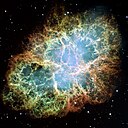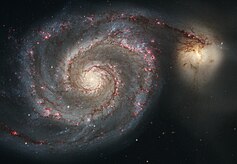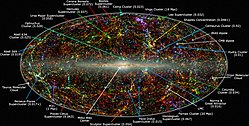













 Selection of astronomical bodies and objects:
Selection of astronomical bodies and objects:
- Moon Mimas and Ida, an asteroid with its own moon, Dactyl
- Comet Lovejoy and Jupiter, a giant gas planet
- The Sun; Sirius A with Sirius B, a white dwarf; the Crab Nebula, a remnant supernova
- A black hole (artist concept); Vela Pulsar, a rotating neutron star
- M80, a globular cluster, and the Pleiades, an open star cluster
- The Whirlpool galaxy and Abell 2744, a galaxy cluster
- Superclusters, galactic filaments and voids

This is a list of lists, grouped by type of astronomical object.
Solar System
- List of Solar System objects
- List of gravitationally rounded objects of the Solar System
- List of Solar System objects most distant from the Sun
- List of Solar System objects by size
- Lists of geological features of the Solar System
- List of natural satellites (moons)
- Lists of small Solar System bodies
- Lists of comets
- List of meteor showers
- Minor planets
Exoplanets and brown dwarfs
Stars
- Lists of stars
- List of nearest stars
- List of brightest stars
- List of hottest stars
- List of nearest bright stars
- List of most luminous stars
- List of most massive stars
- List of largest known stars
- List of smallest stars
- List of oldest stars
- List of stars with proplyds
- List of variable stars
- List of semiregular variable stars
- List of stars that dim oddly
- List of X-ray pulsars
- List of brown dwarfs
- List of supernovae
- List of white dwarfs
Star constellations
Star clusters
- List of open clusters
- List of globular clusters
- List of stellar streams
- List of nearby stellar associations and moving groups
Nebulae
Galaxies
- Satellite galaxies
- List of satellite galaxies of the Milky Way
- List of Andromeda's satellite galaxies
- List of Triangulum's suspected satellite galaxies
Galaxy groups and clusters
- List of galaxy groups and clusters
- List of galaxy superclusters
- List of galaxy filaments
- List of large quasar groups
Black holes
Other lists
- List of voids
- List of largest cosmic structures
- List of the most distant astronomical objects
- List of neutron stars
- List of most massive neutron stars
- List of multiplanetary systems
Astronomical catalogues
- List of astronomical catalogues
Map of astronomical objects
 In this map of the Observable Universe, objects appear enlarged to show their shape. From left to right celestial bodies are arranged according to their proximity to the Earth. This horizontal (distance to Earth) scale is logarithmic.
In this map of the Observable Universe, objects appear enlarged to show their shape. From left to right celestial bodies are arranged according to their proximity to the Earth. This horizontal (distance to Earth) scale is logarithmic.
See also
- American Astronomical Society
- Outline of astronomy
- Lists of astronauts
- List of government space agencies
- List of planetariums
- Lists of space scientists
- Lists of spacecraft